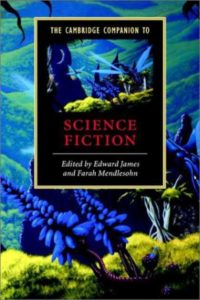 This is an anthology, a set of twenty chapters written by experts and academics about the genre of science fiction up to 2003.
This is an anthology, a set of twenty chapters written by experts and academics about the genre of science fiction up to 2003.
I was an avid reader of SF in the 1960’s and 1970s, during the “New Wave,” but that doesn’t mean I knew anything about the genre. I just read novels I liked by authors who had given me pleasure in the past. This book was a chance for me to take a comprehensive overview of the whole field.
History, for this book, begins in earnest around 1926 with the pulp SF magazines like Astounding Science Fiction. A short chapter gives the nod to historical antecedents such as Jules Verne and to Swift’s Gulliver’s Travels, but “modern” SF begins with the pulps and “modern” technology, such as computers and spaceships, according to this account.
The book is mostly a list of notable SF publications during the period 1929 to 2002, with a phrase, or a sentence or two describing each. The descriptions are suggestive but that’s all. I developed a reading list and a sense of “what’s been done,” but no real insight into what drove the form.
One of the best features of the book is a dense, eight-page chronology of notable SF titles, from Thomas More’s Utopia of 1516, to Kim Stanley Robinson’s The Years of Rice and Salt in 2002. With about fifty titles on a page, that’s nearly 400 SF books one should read to have a thorough grounding in the field. I’d read about 10% of them but made a list of a couple dozen more “must-reads.”
The meat of the book is found in various critical theories brought to bear on the corpus of SF literature. One chapter (a notably weak one, I thought) extracts Marxist theory from SF themes, while another, much more convincing, identifies feminist themes. Chapters also highlight utopias, “hard” SF, race, and religion, along with many other analytic approaches. In each, the style continues: mention the title and author and give a sentence or two of description. There’s no in-depth analysis.
I could easily track the presence of psi-fi over the period. Feminist themes, for example, are about human psychology, whether the story features utopias or particle beams. The same is true for themes involving race and religion. By contrast, very plentiful galactic war stories offer little more than sci-fi.
The index has a few general terms but is really an index of authors. You won’t find a header for Neuromancer (1984), for example, though William Gibson is indexed. The book therefore isn’t very useful as a reference. It seems to be written by academics, each with their own agenda, for use in a (deadly) college course.
The book did give me a high-level overview of the SF literature up to 2002, at least in terms of the major titles, and a hint of what themes have been mined over the years, but not much in the way of aesthetic evaluation or insight into what ideas and social forces motivated the writers and their readers. For that, a better choice is The History of Science Fiction, by Adam Roberts, Palgrave, 2016.
James, Edward, & Farah Mendlesohn (Eds.) (2003). The Cambridge Companion to Science Fiction. Cambridge, U.K.: Cambridge University Press (295 pp.).